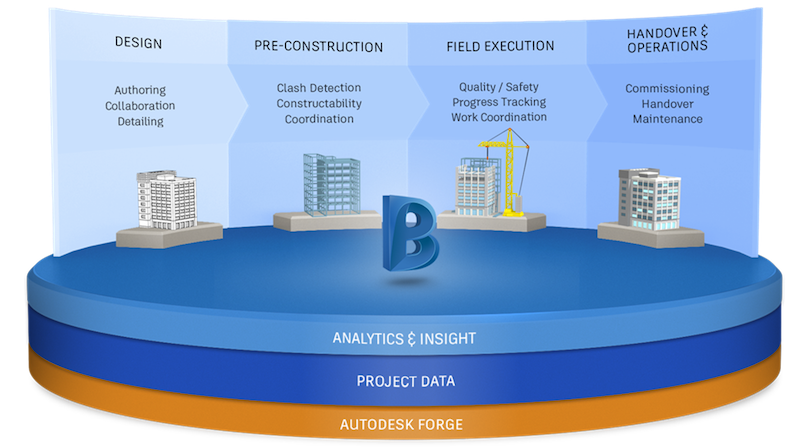This month, Autodesk will be rolling out its next generation of BIM 360 products that will include BIM 360 Design and BIM 360 Build modules (https://bim360.autodesk.com), making this suite the industry's first unified design-construction platform. BIM 360 is built on top of Forge, Autodesk’s cloud-based software platform, which the company launched in 2015.
In fact, all of Autodesk’s products are now built onto Forge, which makes it easier for the company to “expose the innards of technology” through a variety of application program interfaces, says Jim Lynch, Vice President of Autodesk’s BIM 360 Construction Line Group.
By opening Forge to the industry’s eco system, more of Autodesk’s customers have been building products that integrate seamlessly with that platform. One such example is Assemble Systems, a preconstruction planning tool. Indeed, since introducing this partnership program last November at its Autodesk University event, there have been 46 completed integrations on the exchange (https://integrations.bim360.autodesk.com), and another 90 in the works.
Expanding this eco system is important, explains Lynch, because it would be nearly impossible for Autodesk alone to meet all of the AEC industry’s different needs and requirements.
The goal, says Lynch, is the make the construction process easier, from design to commissioning, “so that there’s more end-to-end transparency.”
Third-party suppliers that want to become part of this network need to apply, although Lynch says that the entry bar is “pretty low.” In fact, competing companies that offer software that does pretty much the same thing as others on the exchange are welcome onto the Forge platform. (Lynch says that Autodesk might even invest in the ones it prefers.)
However, in building this app exchange, Lynch says Autodesk more interested in cultivating quality than quantity to help users connect and store their data. “What we’re trying to say is, if you work with Autodesk, you have the opportunity to put all of your information into one place. We’re putting everything on the cloud and offering customizable solutions.”
Related Stories
| Jan 4, 2011
6 green building trends to watch in 2011
According to a report by New York-based JWT Intelligence, there are six key green building trends to watch in 2011, including: 3D printing, biomimicry, and more transparent and accurate green claims.
| Jan 4, 2011
LEED standards under fire in NYC
This year, for the first time, owners of 25,000 commercial properties in New York must report their buildings’ energy use to the city. However, LEED doesn’t measure energy use and costs, something a growing number of engineers, architects, and landlords insist must be done. Their concerns and a general blossoming of environmental awareness have spawned a host of rating systems that could test LEED’s dominance.
| Dec 17, 2010
New engineering building goes for net-zero energy
A new $90 million, 250,000-sf classroom and laboratory facility with a 450-seat auditorium for the College of Electrical and Computer Engineering at the University of Illinois at Urbana/Champaign is aiming for LEED Platinum.
| Dec 6, 2010
Honeywell survey
Rising energy costs and a tough economic climate have forced the nation’s school districts to defer facility maintenance and delay construction projects, but they have also encouraged districts to pursue green initiatives, according to Honeywell’s second annual “School Energy and Environment Survey.”
| Nov 29, 2010
Data Centers: Keeping Energy, Security in Check
Power consumption for data centers doubled from 2000 and 2006, and it is anticipated to double again by 2011, making these mission-critical facilities the nation’s largest commercial user of electric power. Major technology companies, notably Hewlett-Packard, Cisco Systems, and International Business Machines, are investing heavily in new data centers. HP, which acquired technology services provider EDS in 2008, announced in June that it would be closing many of its older data centers and would be building new, more highly optimized centers around the world.
| Nov 16, 2010
Calculating office building performance? Yep, there’s an app for that
123 Zero build is a free tool for calculating the performance of a market-ready carbon-neutral office building design. The app estimates the discounted payback for constructing a zero emissions office building in any U.S. location, including the investment needed for photovoltaics to offset annual carbon emissions, payback calculations, estimated first costs for a highly energy efficient building, photovoltaic costs, discount rates, and user-specified fuel escalation rates.
| Nov 9, 2010
12 incredible objects being made with 3D printers today
BD+C has reported on how 3D printers are attracting the attention of AEC firms. Now you can see how other creative types are utilizing this fascinating printing technology. Among the printed items: King Tut’s remains, designer shoes, and the world’s smallest Rubik’s Cube.
| Nov 5, 2010
New Millennium’s Gary Heasley on BIM, LEED, and the nonresidential market
Gary Heasley, president of New Millennium Building Systems, Fort Wayne, Ind., and EVP of its parent company, Steel Dynamics, Inc., tells BD+C’s Robert Cassidy about the Steel Joist Manufacturer’s westward expansion, its push to create BIM tools for its products, LEED, and the outlook for the nonresidential construction market.












